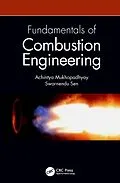This book is an introductory text on fundamental aspects of combustion including thermodynamics, heat and mass transfer and chemical kinetics which are used to systematically derive the basic concepts of combustion. Apart from the fundamental aspects, many of the emerging topics in the field like microscale combustion, combustion dynamics, oxy-fuel combustion and combustion diagnostics are also covered in the book. This would help the beginners in the subject to get initiated to the state of the art topics.
Key Features:
- Coverage of the essential aspects of combustion engineering suitable for both beginners and practicing professionals
- Topics like entropy generation, microscale combustion, combustion diagnostics, second law-based analysis exclusive to the title
- Balanced treatment of thermodynamics, transport phenomena and chemical kinetics
- Discussion on state of the art techniques in combustion diagnostics
- Illustrates combustion of gaseous, liquid and solid fuels along with emission of pollutants and greenhouse gases
Autorentext
Achintya Mukhopadhyay is a Professor of Mechanical Engineering at Jadavpur University, Kolkata (Calcutta), India. He also served as Professor of Mechanical Engineering at Indian Institute of Technology Madras. Dr. Mukhopadhyay also held visiting positions at Technical University of Munich where he was an Alexander von Humboldt Fellow and University of Illinois at Chicago. Dr. Mukhopadhyay's teaching and research interests include thermodynamics, heat transfer, combustion, multiphase flows and design and analysis of thermal systems. Dr. Mukhopadhyay has over 275 research publications including over 100 international journal publications. Dr. Mukhopadhyay is a Fellow of the West Bengal Academy of Science and Technology and International Society for Energy, Environment and Sustainability and life member of Indian Society of Heat and Mass Transfer and Indian section of the Combustion Institute.
Swarnendu Sen is a Professor of Mechanical Engineering at Jadavpur University, Kolkata (Calcutta), India. Dr. Sen held visiting position at Technical University of Munich where he was a DAAD Fellow. He also held visiting positions at University of Illinois at Chicago and Virginia Tech, Blacksburg, USA. He worked in HCL Ltd. and Development Consultants Ltd. as graduate engineer in the area of design and analysis. His area of interest covers reacting & multiphase flow, magnetic fluid & nanofluid transport, heat transfer augmentation and combustion synthesis of carbon nano-structures. Dr. Sen has around 300 research publications including over 100 international journal publications. Dr. Sen is a Fellow of the West Bengal Academy of Science and Technology and International Society for Energy, Environment and Sustainability. He is a life member of Indian section of the Combustion Institute, Indian Society of Heating, Refrigerating and Air Conditioning Engineers and Indian Society of Heat and Mass Transfer.
Inhalt
Chapter 1: Introduction
1.1 Introduction to Combustion
1.2 Applications of Combustion
1.3 Approaches to Combustion Study
1.4 Types of Combustion
References
Chapter 2: Thermodynamics of Reacting Systems
2.1 Review of Thermodynamics
2.2 Fuels
2.3 Stoichiometry
2.4 First Law for Reacting Systems
2.5 Chemical Equilibrium
2.6 Applications/ Case Studies
Exercise
References
Chapter 3: Chemical Kinetics
3.1 Introduction
3.2 Global and Elementary Reactions
3.3 Bimolecular Reactions
3.4 Collision Theory of Reaction Rates
3.5 Unimolecular Reactions
3.6 Termolecular Reaction
3.7 Chain Reactions
3.8 Chemical Time Scales
3.9 Relation between kinetic rate coefficients and equilibrium constants
3.10 Multistep Mechanism
3.11 Steady State Approximation
3.12 Partial Equilibrium Approximation
Exercise
References
Chapter 4: Simple Reactor Models
4.1 Constant Pressure Reactors
4.2 Constant Volume Reactor
4.3 Well-Stirred Reactor
4.4 Plug Flow Reactor
Exercise
References
Chapter-5: Conservation Equations
5.1 Reynolds Transport Theorem
5.2 Conservation of Mass
5.3 Conservation of Species
5.4 Conservation of Momentum
5.5 Conservation of Energy
5.6 Entropy Balance Equation
References
Chapter 6: Laminar Premixed Flames
6.1 Physical Description
6.2 Rankine-Hugoniot Relations
6.3 Flame Propagation and Flame Speed
6.4 Determination of Flame Speed
6.5 Simplified Analysis
6.6 Factors Affecting Flame Speed
6.7 Flame Quenching and Ignition
6.8 Flame Propagation in Microscale Combustors
6.9 Flame Stability, Lift-off, Blowout and Flashback
6.10 Flame Stretch
Exercise
References
Chapter-7: Laminar Non-premixed Flames
7.1 Physical Description
7.2 Simplified Analysis of Diffusion Controlled Systems
7.3 Conserved Scalar Formulation
7.4 Shvab- Zeldovich Formulation
7.5 Analysis of Typical Flame Configurations
7.6 Partially Premixed Flame
7.7 Soot Generation
7.8 Effect of Exit Velocity on Jet Flames
Exercise
References
Chapter 8: Droplet and Spray Combustion
8.1 Spray Formation
8.2 Evaporation of Single Droplet
8.3 Combustion of Single Droplet
8.4 Multicomponent, High Pressure Convective Effects
8.5 Physical Description of Spray Combustion
8.6 Simplified Analysis of Spray Combustion
Exercise
References
Chapter 9: Modelling of Turbulent Combustion
9.1 Turbulent Flows
9.2 Modelling approaches for turbulence
9.3 Need for Combustion modelling
9.4 Turbulent Premixed Combustion
9.5 Turbulent Non-premixed Combustion
9.6 Turbulent Partially-premixed Combustion
Exercise
References
Chapter-10: Combustion of Solid Fuels and Surface Reactions
10.1 Heterogeneous Combustion
10.2 Burning of Coal
10.3 Combustion of Coal
10.4 Combustion of Solid Propellants
10.5 Catalytic Reaction
Exercise
References
Chapter 11: Combustion Emission
11.1 Introduction
11.2 Emission of Pollutant Gases
11.3 Emission of Greenhouse Gases
11.4 Emission of Particulate Matter
11.5 Abatement of Emission
11.6 Emission Quantification
Exercise
References
Chapter 12: Combustion Diagnostics
12.1 Overview
12.2 Flow Field Measurement
12.3 Temperature Measurement
12.4 Species and Concentration Measurement
12.5 Pressure Measurement
12.6 Soot Measurement
12.7 Droplet and Spray Measurement
References
Appendix
